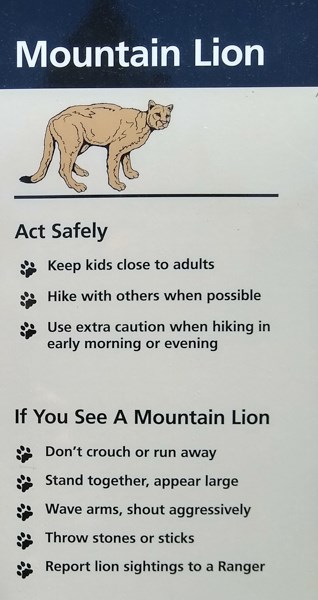To stay safe in mountain lion territory, make noise and travel in groups to deter encounters. Avoid hiking at dawn or dusk when they are most active.
When in mountain lion territory, it’s essential to take precautions to ensure your safety. By understanding their behaviors and taking necessary steps, you can enjoy outdoor activities without putting yourself at risk. This guide will provide you with practical tips on how to navigate mountain lion habitats and minimize the chances of encountering these majestic yet potentially dangerous animals.
By being alert, prepared, and respectful of their territory, you can have a safe and enjoyable experience exploring the great outdoors. Remember, being proactive and informed is key to staying safe in mountain lion territory.


Credit: www.treelinereview.com
Recognizing Mountain Lion Territory
Identifying mountain lion habitats: Mountain lions prefer dense vegetation, rocky terrain, and canyons for hunting and resting.
In the wild, they are solitary and elusive predators, active primarily at dawn and dusk.
- They are territorial animals, marking their territories with urine and scratch marks.
- Mountain lions are exceptional climbers and can leap up to 15 feet vertically.
Ensuring Safety In Mountain Lion Territory
When hiking, make noise to alert mountain lions of your presence without surprising them.
- Keep children close by and avoid hiking alone, particularly during dawn or dusk.
- Carry bear spray and learn how to use it for self-protection in case of an encounter.
If you encounter a mountain lion, maintain eye contact, make yourself big, and back away slowly.
“`
Credit: mwvvibe.com
Essential Safety Tips
When venturing into mountain lion territory, it is crucial to keep safety as the top priority. Here are the essential safety tips to follow:
Hiking In Groups
Hiking in groups is a wise practice as mountain lions are less likely to approach larger numbers of people.
Making Loud Noises While Hiking
Making loud noises while hiking helps in alerting mountain lions of your presence, reducing the risk of unexpected encounters.
Camping And Cooking Precautions
Camping and cooking precautions are essential to keep food smells contained and prevent attracting mountain lions to your campsite.
Being Prepared
Being prepared is essential when venturing into mountain lion territory. Whether you are an avid hiker, camper, or outdoor enthusiast, it’s crucial to take proactive measures to ensure your safety. Knowing how to carry and use bear spray or an air horn and understanding what to do if you encounter a mountain lion can make a significant difference in potentially hazardous situations.
Carrying Bear Spray Or Air Horn
Carrying bear spray or an air horn is a proactive measure to deter mountain lions from approaching. Bear spray is a highly effective form of deterrent and can be used from a considerable distance to create a barrier between you and the mountain lion. Similarly, an air horn can produce a loud, startling noise to deter the animal. Keeping these items within reach can provide a sense of security while in mountain lion territory.
Knowing What To Do If You Encounter A Mountain Lion
Encountering a mountain lion can be a frightening experience, but being aware of the appropriate actions to take is crucial. If you encounter a mountain lion, it’s important to appear as large as possible, make loud noises, and slowly back away without turning your back on the animal. Avoid crouching or bending down, as this may trigger a predatory response. Remember to maintain eye contact and give the mountain lion an avenue of escape if possible.

Credit: dayhikesneardenver.com
Understanding Mountain Lion Behavior
Discover the behavior of mountain lions to learn how to be safe in their territory. Understanding their habits and how to act when in their presence is crucial for avoiding conflicts and ensuring your safety in mountain lion territory. Knowing their behavior can help you minimize the risks and enjoy the outdoors with confidence.
Learning About Hunting And Feeding Patterns
Mountain lions, also known as cougars or pumas, are solitary creatures with secretive hunting behaviors. Understanding their hunting and feeding patterns is essential for staying safe in mountain lion territory. These big cats are opportunistic predators that primarily target deer, elk, and other ungulates. They rely on stealth and ambushing techniques to capture their prey. To protect yourself and your loved ones, it is crucial to be aware of the following key points regarding mountain lion behavior: 1. Nocturnal Predators: Mountain lions are mostly active during the twilight hours, dawn, and dusk. They have excellent night vision, which aids them in hunting under cover of darkness. Therefore, it is advisable to avoid venturing into mountain lion territory during these times. 2. Ambush Attacks: Mountain lions are skilled stalkers and prefer surprising their prey from close range. They rely on their exceptional athleticism and powerful hind legs to launch a swift attack. Be cautious when hiking or jogging in areas with dense vegetation or rock formations that could provide cover for a mountain lion. 3. Travel Corridors: Mountain lions use specific travel routes known as travel corridors. These paths help them efficiently navigate their hunting grounds while conserving energy. It is advisable to avoid hiking or walking near these routes to reduce the chances of encountering a mountain lion. 4. Cached Kills: Mountain lions are known to cache their kills, meaning they bury their prey to return to it later. If you stumble upon a carcass, be cautious, as it might indicate that a mountain lion is nearby. Leave the area immediately and report the sighting to the local wildlife authorities.Identifying Signs Of Mountain Lion Presence
Recognizing signs of mountain lion presence can help you determine if you are in an area inhabited by these elusive creatures. Pay attention to the following indicators: 1. Tracks and Paw Prints: Mountain lion tracks have distinct characteristics. Their prints do not usually show claws, and they have a round shape with three lobes at the bottom. If you observe tracks resembling these descriptions, exercise caution. 2. Scratch Marks and Scat: Mountain lions occasionally scratch trees, logs, or the ground to mark their territory. Look for fresh claw marks and droppings in the area. Mountain lion scat is cylindrical and segmented, often containing hair and bones. 3. Game Trails: Mountain lions tend to use established game trails as they offer the easiest and most inconspicuous passage. If you encounter frequent signs of ungulate activity, such as flattened grass and pathway-like formations, it could indicate mountain lion presence. 4. Vocalizations: Mountain lions communicate through various vocalizations, including screams, growls, and hisses. If you hear these sounds in the vicinity, it is essential to remain alert and cautious. Remember, while it is important to be aware of mountain lion behavior and signs of their presence, encounters with these animals are rare. By familiarizing yourself with these guidelines and adopting proactive safety measures, you can minimize the risks while enjoying the beauty of mountain lion territory. Stay safe and respect the natural habitats of these magnificent creatures.Additional Resources
When it comes to staying safe in mountain lion territory, it’s always a good idea to arm yourself with knowledge and resources to ensure a secure and enjoyable outdoor experience. Whether you’re an avid hiker or a nature enthusiast, these additional resources will provide you with valuable guidance and information about local regulations. So, let’s dive in and explore the following resources:
Guidance From Wildlife Agencies
Wildlife agencies play a crucial role in managing and protecting the natural habitats and wildlife populations, including mountain lions. These agencies have comprehensive guidelines and recommendations that can help you understand the behavior of mountain lions and mitigate potential risks. Here are some essential wildlife agency resources to consult:
- National Park Service (NPS): The NPS provides valuable information specifically tailored to parks and recreational areas where mountain lions are present. Their guidance includes tips on how to behave in mountain lion territory, what to do if you encounter a mountain lion, and how to report any sightings or incidents. Visit their website for the latest updates and guidelines.
- U.S. Fish and Wildlife Service (USFWS): The USFWS is another reliable source for mountain lion safety information. They offer educational materials, brochures, and fact sheets that delve into the characteristics and habits of mountain lions, as well as precautionary measures to minimize the risks associated with these majestic predators.
- State Fish and Wildlife Agencies: Each state often has its own fish and wildlife agency, which provides localized guidance on mountain lion safety. These agencies are typically well-versed in the unique challenges and regulations specific to your region. Make sure to check their websites for resources, including safety tips, trail guidelines, and any recent reports of mountain lion activity.
Information About Local Regulations
Understanding the regulations and requirements specific to the areas you plan to explore is essential for staying safe in mountain lion territory. Local regulations may vary depending on the location, and it’s crucial to stay informed and comply with these rules. Here are some useful resources to obtain information about local regulations:
- Department of Fish and Wildlife: State or regional departments of fish and wildlife are responsible for managing and conserving wildlife resources. They often have detailed information about local regulations regarding mountain lions, including hunting seasons, areas with restricted access, and any public safety notices. Check their websites or contact them directly to ensure you have the most up-to-date information.
- Park and Recreation Authorities: If you plan on hiking or camping in specific parks or recreational areas, it’s essential to review the regulations enforced by the governing authorities. These regulations may specify areas where mountain lions are known to roam or dictate specific guidelines for ensuring visitor safety. Be sure to visit their websites or contact them beforehand to familiarize yourself with any relevant regulations.
Remember, knowledge is the key to staying safe in mountain lion territory. By consulting these guidance resources from wildlife agencies and familiarizing yourself with local regulations, you can ensure a safer and more enjoyable experience in the great outdoors.
Frequently Asked Questions Of How To Stay Safe In Mountain Lion Territory
How Common Are Mountain Lion Attacks On Humans?
Mountain lion attacks on humans are extremely rare. According to the National Park Service, there have been only 20 reported fatal attacks in North America over the past 100 years. More people are injured or killed by domestic dogs than by mountain lions.
How Can I Minimize The Risk Of A Mountain Lion Encounter?
To reduce the risk of a mountain lion encounter, make noise while hiking to alert them of your presence. Travel in groups and keep children close. Avoid hiking at dawn, dusk, or at night. Carry bear spray, make yourself appear larger if you encounter a mountain lion, and never run away from it.
What Should I Do If I Encounter A Mountain Lion?
If you come face-to-face with a mountain lion, do not run. Instead, stay calm and face the animal, maintaining eye contact. Speak firmly and loudly, and slowly back away while giving the mountain lion a way to escape. Do not bend down or turn your back on the lion.
Conclusion
To sum up, being aware of your surroundings and following safety guidelines is crucial in mountain lion territory. By making noise, keeping pets on a leash, and being cautious during dawn and dusk, you can minimize the risk of encountering a mountain lion.
Remember, respecting their habitat is key to coexisting with these magnificent animals.
